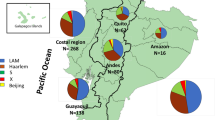Abstract
The MIRU-12 and MIRU-24 methods were used for genotyping and estimation of M. tuberculosis population structure in Buryatia. It was studied in 283 strains isolated from individuals from the regional TB dispensary and medical clinics of the penitentiary system of the republic. It was found that the prevalence of pandemic genotypes Beijing MIT17 and MIT16, as well as subtype Beijing MIT642 (24.5%–46/188), were dominant in the studied area. The isolates of the Beijing MIT642 were common among all groups of patients with pulmonary tuberculosis with the tendency to formation of MDR and chronic course of the disease.
Similar content being viewed by others
References
Sinkov, V.V., Savilov, E.D., and Ogarkov, O.B., Epidemiology of tuberculosis in Russia: Epidemiological and historical evidences in favor of the scenario distribution of Beijing genotype M. tuberculosis in the XX century, Epidemiol. Vaktsinoprofilakt., 2010, vol. 55, no. 6, pp. 23–28.
Ogarkov, O., Zhdanova, S., Savilov, E., Mokrousov, I., Sinkov, V., and Antipina, S., Lethal’ combination of Mycobacterium tuberculosis Beijing genotype and human CD209-336G allele in Russian male population Infection, Genet. Evol., 2012, vol. 12, no. 4, pp. 732–736.
Zhdanova, S.N., Ogarkov, O.B., Stepanenko, L.A., Lats, A.A., Sin’kov, V.V., Untanova, L.S., Alekseeva, G.I., and Savilov, E.D., The deletion analysis of rd105 is a useful tool in the evaluation of Beijing strains of Mycobacterium tuberculosis, Byull. Vost.-Sibirsk. Nauch. Tsentra SO RAMN, 2011, vol. 2, pp. 194–197.
Medvedeva, T.V., Ogarkov, O.B., Nekipelov, O.M., Ushakov, I.V., Koz’yakova, E.S., and Skvortsova, R.G., MIRU-VNTR genotyping of Mycobacterium tuberculosis strains from East Siberian Beijing family versus Kilimanjaro family, Mol. Genet., Mikrobiol. Virusol., 2004, vol. 4, pp. 33–38.
Reed, M., Pichler, V.K., McIntosh, F., Mattia, A., Fallow, A., Masala, S., et al., Major Mycobacterium tuberculosis lineages associate with patient country of origin, J. Clin. Microbiol., 2009, vol. 47, no. 4, pp. 1119–1128.
Ogarkov, O.B., Zhdanova, S.N., Zarbuev, A.N., Badleeva, M.V., Untanova, L.S., Temirbaeva, I.V., Lats, A.A., and Savilov, E.D., Genetic polymorphism of Mycobacterium tuberculosis from patients in the penitentiary system of Buryatia: high prevalence of Beijing family strains, Sib. Med. Zh., 2012, vol. 6, pp. 54–57.
Makinen, J., Marjamäki, M., Haanperä-Heikkinen, M., Marttila, H., Endourova, L.B., et al., Extremely high prevalence of multidrug resistant tuberculosis in Murmansk, Russia: a population-based study, Eur. J. Clin. Microbiol. Infect. Dis., 2011, vol. 30, pp. 1119–1126.
Markelov, Yu.M. and Narvskaya, O.V., Circulation of multidrug-resistant tuberculosis pathogen strains in the Republic of Karelia, Tuberk. Bolezhi Legkik, 2010, vol. 2, pp. 54–56.
Mokrousov, I., Vyazovaya, A., Otten, T., Zhuravlev, V., Pavlova, E., Tarashkevich, L., Krishevich, V., Vishnevsky, B., and Narvskaya, O., Mycobacterium tuberculosis population in northwestern Russia: An update from Russian-EU/Latvian border region, PLoS One, 2012, vol. 7, no. 7, p. e41318. doi 10.1371/journal.pone.0041318
Narvskaya, O., Mokrousov, I., Otten, T., and Vishnevsky, B., Molecular markers: application for studies of Mycobacterium tuberculosis population in Russia, in Trends in DNA Fingerprinting Research, Read, M.M., Ed., New York: Nova Science Publ., 2005, pp. 111–125.
Norkina, O.V., Kinsht, V.N., Mokrousov, I.V., Kurunov, I.N., Krasnov, V.E., et al., The genetic diversity of Mycobacterium tuberculosis and an assessment of risk factors of tuberculosis spread in Russia’s Siberian region by molecular epidemiological methods, Mol. Gen. Mikrobiol. Virusol., 2003, vol. 3, pp. 9–18.
Toungoussova, O.S., Sandven, P., Mariandyshev, A.O., Nizovtseva, N.I., Bjune, G., et al., Spread of drugresistant Mycobacterium tuberculosis strains of the Beijing genotype in the Archangel oblast, Russia, J. Clin. Microbiol., 2002, vol. 40, pp. 1930–1937.
Zhdanova, S.N., Zorkaltseva, E.Yu., Ogarkov, O.B., Vorobeva, O.A., Untanova, L.S., Alekseeva, G.I., and Savilov, E.D., Description of drug resistant strains Mycobacterium tuberculosis by the molecular genetic techniques, Sib. Med. Zh. (Irkutsk), 2011, vol. 6, pp. 228–230.
Iwamoto, T., Yoshida, S., Suzuki, K., Tomita, M., Fujiyama, R., Tanaka, N., Kawakami, Y., and Ito, M., Hypervariable loci that enhance the discriminatory ability of newly proposed 15-loci and 24-locivariablenumber tandem repeat typing method on Mycobacterium tuberculosis strains predominated by the Beijing family, FEMS Microbiol. Lett., 2007, vol. 270, no. 1, pp. 67–74.
Chen, Y.-Y., Chang, J.-R., Huang, W.-F., Kuo, S.-C., Su, I.-J., et al., Genetic diversity of the Mycobacterium tuberculosis Beijing family based on SNP and VNTR typing profiles in Asian countries, PLoS One, 2012, vol. 7, no. 7, p. e39792. doi 10.1371/journal.pone.0039792
Mokrousov, I., Ly, H.M., Otten, T., et al., Origin and primary dispersal of the Mycobacterium tuberculosis Beijing genotype: clues from human phylogeography, Genome. Res., 2005, vol. 15, pp. 1357–1364.
Lopez, B., Aguilar, D., Orozco, H., et al., A marced difference in pathogenesis and immune response induced by different Mycobacterium tuberculosis genotypes, Clin. Exp. Immunol., 2003, vol. 133, pp. 30–37.
Mokrousov, I., The quiet and controversial: Ural family of Mycobacterium tuberculosis, Infect. Genet. Evol., 2012, vol. 12, no. 4, pp. 619–629.
Author information
Authors and Affiliations
Corresponding author
Additional information
Original Russian Text © S.N. Zhdanova, O.B. Ogarkov, A.A. Laz, A.N. Zarbuev, M.V. Badleeva, L.S. Untanova, E.D. Savilov, 2014, published in Molekulyarnaya Genetika, Mikrobiologiya i Virusologiya, 2014, No. 2, pp. 12–16.
About this article
Cite this article
Zhdanova, S.N., Ogarkov, O.B., Laz, A.A. et al. Identification of ubiquitous and endemic Mycobacterium tuberculosis genotypes in the Republic of Buryatia. Mol. Genet. Microbiol. Virol. 29, 58–62 (2014). https://doi.org/10.3103/S0891416814020086
Received:
Published:
Issue Date:
DOI: https://doi.org/10.3103/S0891416814020086




